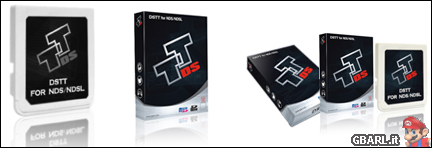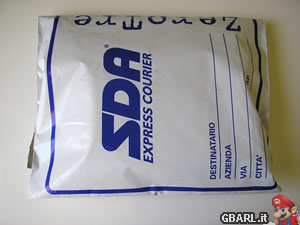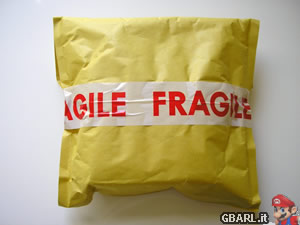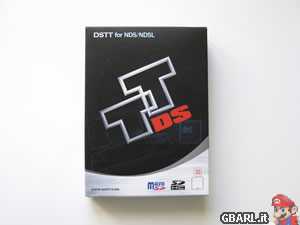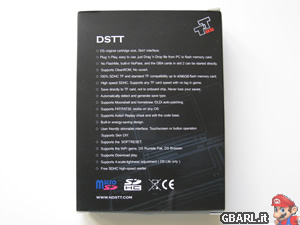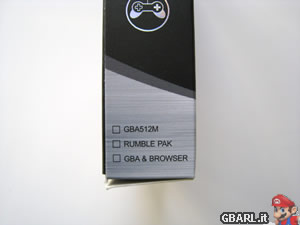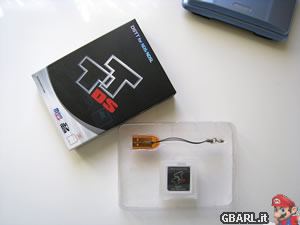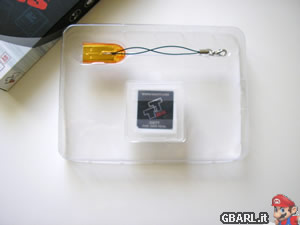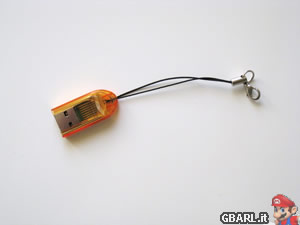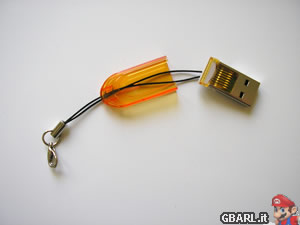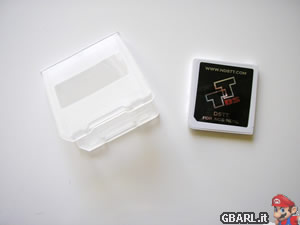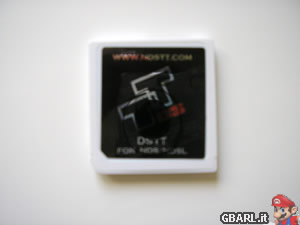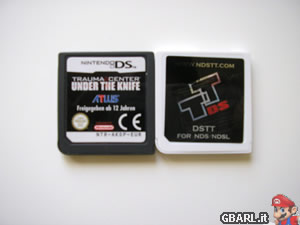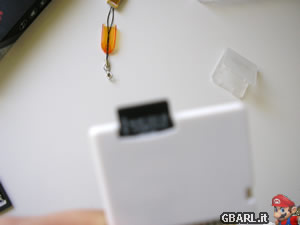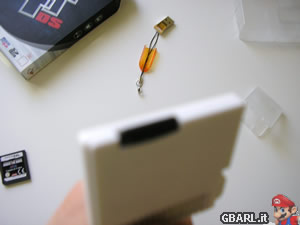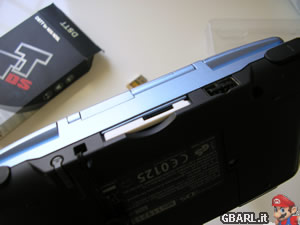Benvenuto Visitatore ( Log In | Registrati )
 Thursday 31 January 2008 - 12:57 Thursday 31 January 2008 - 12:57
Messaggio
#1
|
|
 Fanatic GBA/NDS Gruppo: Membri Messaggi: 985 Iscritto il: Fri 24 August 2007 - 11:45 Da: Chioggia (VE) Utente Nr.: 20.904 Feedback: 0 (0%) |
Quick Links Homepage: www.ndstt.com Our heartfelt thanks to Ultragames for providing the sample. The Nintendo DS flashcard's scene is undeniable mature: all the big players gave their best, creating extremely refined solutions with ever more "collateral" features, thanks to the almost complete knowledge of Nintendo's gaming hardware. Neverthless, a new brand would occasionally join the match: this is how Team TT introduces itself, releasing its very first product, a simple and low-cost Slot 1 flashcard aptly named DSTT. Here we are again at our workbench, ready to squeeze 'till the end this new flash kit, unveiling its secrets, strong and weak points; in our review every curiosity you have will be fulfilled. Introduction & Features Before starting, it's best to clarify that, no matter the now widespread rumors, this flashcard isn't absolutely related to the -deservingly- famous R4 Revolution, already reviewed on this site and currently powering many of your DS'es. It's indeed assembled in the same factory that gave birth to the aforementioned flash kit, yet the DSTT is a completely different product, to the point that it's also marketed, along with a few accessories, as the Top Toy DS, a Neoflash product. However, the software that powers the card is, partially or completely, derivated from the R4 OS: the Action Replay cheats database, for instance, is fully compatible as long as you don't use an encrypted one. Having debunked this myth, we can now begin our review by placing the TT in the same vein as the R4 and M3 DS Simply, a Slot 1 unit marked by ease of use and mainteinance, identical to a standard issue Nintendo cartridge and with virtually enormous storage capabilities granted by high-capacity microSD's. The similarities with said brands are absolutely obvious: this is positive though, considering this design's prerogatives. Furthermore, the operating system is easy to use and completely customizable, by now a fairly standard feature. But let's now take a look at the features breakdown, as declared by the manufacturer:
Whether this is truly a candidate for the R4 throne or a passenger on the train for oblivion, we'll find out in our review. -------------------- Release List EURO e USA aggiornata settimanalmente:
http://www.gbarl.it/index.php?showtopic=41974 |
|
|
|
 |
Risposte
 Friday 1 February 2008 - 15:24 Friday 1 February 2008 - 15:24
Messaggio
#2
|
|
 Fanatic GBA/NDS Gruppo: Membri Messaggi: 985 Iscritto il: Fri 24 August 2007 - 11:45 Da: Chioggia (VE) Utente Nr.: 20.904 Feedback: 0 (0%) |
The SDA plastic envelope is now sitting on our workbench, with the sample securedly housed within. We do have to complain with Poste Italiane's express courier: no matter how carefully the package was prepared, it was clear how it withstood quite an abuse, probably being shipped under the weight of other boxes... As usual, cutting it open allowed us to free the content, a cardboard envelope containing the DSTT, whose packaging is shown in the images below. It takes only a quick glance to notice how essential the box is: the front sports the flashcard logo on a black background, with the usual "for NDS/NDSL" markings printed in the top left corner, in reflective letters; the lower margin shows the manufacturer's website (which will be useful later on, when the user will be required to download the system software, an issue we'll further discuss) and the logos for the micro Secure Digital and Secure Digital High Capacity standards respectively. On the back, a full list of the TT's features is available to the user: in short, it's the same we mentioned in the previous paragraph, complete with Engrish (it wouldn't be fun, otherwise). We found amusing how the CE and "please dispose of carefully" logos have been printed on the box: sure, we admire the attention TT Team showed towards ecology, but we highly doubt the average user would be so prone on getting rid of his brand new flashcard Now, the sides: besides the three refractive icons clearly inspired by the PSP's trademark games, music, movies triad, we can find a small list of three items.
Let's go ahead and open the box, where a plastic tray resides: after some fumbling, we managed to pull it out and access the DSTT itself, along with a compact microSD reader/keyring, available in blue or orange (fate will decide which one you get, though!). Unfortunately, the bad habit of not including any quick manual or driver disc has spread even to this new team: the user has to figure the card's functions by himself, or browse the official site. We can't say we're satisfied by the card's packaging: its sturdiness has been demonstrated by its unceremonious delivery, but little will it do to guide a first-time users left staring at the card and microSD reader, wondering how to get everything the features list promised. Indeed, Slot 1 designs make software discs obsolete, yet not everyone is knowledgeable enough to set up the TT on his own, let alone the fact that said required files are available only via the official site. To sum it up, we're far, far away from G6 tin boxes, and even farther from the latest Supercards' superb ones, even though its resilience against damage impressed us. As we mentioned, multiple accessories exist, ranging from a system disc to the mandatory GBA/Rumble/RAM packs up to a USB battery charger, but finding them is easier said than done. We diligently mailed the manufacturer for an official statement, but we were left without an answer, which proved to be somewhat annoying. This review will be updated accordingly, but for now we will continue our tests using the sample we were gently provided. About the micro USB card reader: this is the first time we've found such a small one bundled with a flashcard. Lightweight, discreet, easy to hook to your keyring; its usage is as simple and elegant as it gets. The entire circuitry is housed in a clear plastic sleeve and can be freed by simply sliding your thumb over the top side; the microSD is inserted into the reader through a tiny slot on the top and the entire apparatus is then plugged into your favorite USB 2.0 port for easy and fast transfer of games, homebrews and updates. So simple, so cool. Nevertheless, we wouldn't advise using too much this particular card reader: in addition to being a little too tiny for our taste, our sampe had an odd habit of getting stuck into the USB port, along with scratching the borders of our microSD card, whose extraction requires you to use your fingernails, due to the lack of a spring-loaded mechanism. Finally, the flashcard itself. Just like an R4, the DSTT is protected by a handy plastic box, not different from those housing common memory cards; on top of that, it's shaped like a DS cartridge, which is a neat touch. Once opened, the TT immediately slides out, falling into our hands: the overall build is excellent, with a sturdy plastic case identical to a standard issue Nintendo cartridge. The top right corner is where the microSD slot is located, while a glossy sticker covers the front, without concealing exposed circuitry underneath. White is the only available color of this product, so no hopes of getting a unit matching your carefully repainted DS: furthermore, we strongly advise not to try and open up the flashcard! Oddly enough, our sample showed how the two halves were kept together by tiny plastic bridges glued together, which made reassembling the unit not an easy task. What we were very impressed by is the extremely accurate spring mechanism: a common flaw of other kits we tested is how, for aesthetics' sake, the microSD has to be pushed beyond the limit of the card's top margin, making the usage of one's fingernail almost mandatory. This is not the case, as a fingertip is more than enough to smoothly insert and eject the memory card, given you're willing to look over the less-than-a-millimetre sticking out. As a closing note, a look at the DStT innards. Due to the little significance it bears for the end user, we routinely avoid removing the protective casing: however, this time we decided to take our examination farther. The overall quality of the printed board is more than average, with well-defined tracks running across both sides, using the same manufacturing processes as the old DS-Link. However, what's soldered on the board is what really caught our attention, and not in a good way. The various elements are poorly assembled, sometimes even not aligned, with an overall feeling of cheapness and rush, obvious to an expert eye. This is nowhere near the carefully designed and accurately built circuitry of an R4. This is an image of how the DSTT looks once ready and inserted into the DS console: it behaves and feels just like a normal came card. To sum it up, this flashcard looks well designed on the outside, but a riddle on the inside: well-built, sturdy, with the best spring-loaded microSD slot we've seen so far, yet we can not shake off the doubts we had while looking at the circuit board, which really suffers from an approximative manufacturing. Let's now take into account the more practical aspects of the DSTT. -------------------- Release List EURO e USA aggiornata settimanalmente:
http://www.gbarl.it/index.php?showtopic=41974 |
|
|
|
Inserisci in questo messaggio
 JohnVS [REVIEW] DS-TT Thursday 31 January 2008 - 12:57
JohnVS [REVIEW] DS-TT Thursday 31 January 2008 - 12:57
 JohnVS Getting Started
When it comes to setting up the D... Monday 4 February 2008 - 10:49
JohnVS Getting Started
When it comes to setting up the D... Monday 4 February 2008 - 10:49
 JohnVS GUI & System Software
Lett's now take a c... Tuesday 5 February 2008 - 12:18
JohnVS GUI & System Software
Lett's now take a c... Tuesday 5 February 2008 - 12:18
 Evrain Compatibility and Performance
After so much talkin... Wednesday 6 February 2008 - 22:01
Evrain Compatibility and Performance
After so much talkin... Wednesday 6 February 2008 - 22:01
 Evrain Final Thoughts
It's time to write down our fin... Thursday 7 February 2008 - 15:38
Evrain Final Thoughts
It's time to write down our fin... Thursday 7 February 2008 - 15:38  |
1 utenti stanno leggendo questa discussione (1 visitatori e 0 utenti anonimi)
0 utenti:

|
Versione Lo-Fi | Oggi è il: Tue 1 July 2025- 22:31 |









